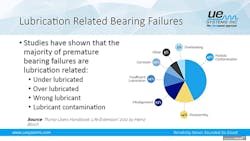Prevent lubrication-related bearing failures with ultrasound
Mike Naro, CMRP, is the training manager for UE Systems, Inc. He is responsible for the UE Systems’ training team globally as well as the training material used in all UE Systems’ training courses. During the live Q&A portion of the webinar, "Ultrasound Assisted Lubrication," Naro tackled several attendee questions on how to optimize a lubrication program using ultrasound technology.
PS: How do I start an ultrasound program and meld it into my time-based lubrication program? Is there a good place to start?
MN: Here’s an example. Let’s say you have a preventative maintenance (PM) schedule that tells you to hit five shots on this asset every two months, and hit 10 shots on that asset every two months. If you have a device like the 201 Grease Caddy, which has red LEDs, is analog, and is easy to use, then eventually it'll meld in with your PM program. Your workers will take the grease caddy with them, and they'll start pumping grease.
Is it the 10 shots that were recommended by the manufacturer, or an equation we figured out? Or is it five shots from the grease caddy and it leveled off, no more? It’s whichever one comes first. Over time, we start melding it into the program, learning to trust it, until we finally convert over to a true condition-based lubrication program.
PS: If the decibels never rise over a certain period of time, at what point do you add grease anyway, or would you ever add grease?
MN: I would say no, or maybe suggest that you consult the manufacturer. I believe in ultrasound, so if (the sound is) not changing, lubrication is not needed. In this scenario, I don't know what the timeframe is. Are the workers used to greasing the asset every two weeks, and they're six months in, and nothing has changed? Then I would leave it alone. Has it been three years? Then I would start investigating because that really doesn't make sense.
There are a lot of questions I would need to ask to drill down and try to figure out what is going on, such as, why is (the sound) not changing? In my experience, it always changes at some point. I've watched decibels rise 55 dB and still turn, and they sound like they're going to fall out, but they're still turning, and they shouldn't be. We all know that bearings act strange sometimes.
PS: I've heard the noise levels on ultrasound when someone deliberately over-greases the bearing, and it gets just as loud as under-greased (bearings), too. That’s the trick, right? If you listen, you can actually hear the decibels go up again if you do add too much grease, so there's a way to know when to stop, in that regard.
MN: Yes. I wonder if the bearing is already over-lubed, and we just don't realize it? That may be one of the answers to this question. The bearing is already over-lubed, and the decibels won't go down. But again, I would have to ask a lot more questions to figure that one out.


